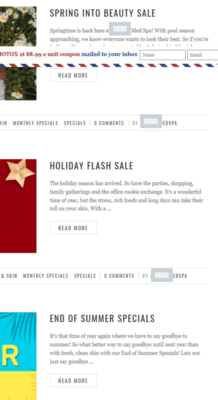INT. PLASTIC SURGERY PRACTICE, PHYSICIAN’S OFFICE
STAFF PERSON
Hey, I have a great idea, doctor! Why don’t you start blogging? I’ve read it’s a great way to get our site rank up, and also you can advertise what we do.
DOCTOR
Mmmm, I dunno. I’m already so busy. And not that much of a writer. What would I write about?
STAFF PERSON
Oh, it doesn’t have to be anything fancy. Just talk about our current specials, or, you know, why a woman should get a mommy makeover. It will be fun!
DOCTOR
All right. If you think it will make our site rank higher on Google, I guess I can give it a shot.
THREE MONTHS LATER
STAFF PERSON
Hey, we haven’t updated our blog in weeks. Can you write a post about facelifts or something?
DOCTOR
I just don’t have time to do this. Can’t you just cut-and-paste the article about me winning the top doc award or something? I know: every month at the staff meeting, we’ll decide on the upcoming specials, and then you can post that to the blog. It will only be once a month, but at least it will be something to send to our mailing list.
What is the point of your plastic surgery blog?
I hope the little screenplay I wrote above sounds familiar, because I took it from real life. A similar scene actually played out at the plastic surgery practice I worked for in my previous life as a nurse.
A lot of people have great ideas about how to promote their plastic surgery practice. And it’s true that blogging regularly can pay big dividends. As I wrote in Chapter Six of my ebook, 7 Deadly Sins of Healthcare Content Writing that Kill SEO and Turn Off Prospective Clients, a blog can:
- Elevate your search rank
- Make a human connection with clients and prospective clients
- Keep your services top-of-mind (especially if you email the blog post to your list)
- Enhance your credibility as an expert
- Lead to media coverage
But those benefits only accrue from doing a blog the right way. And the right way begins with establishing the purpose of your blog.
What a plastic surgery blog should NOT be
A quick Google search reveals hundreds of plastic surgery blogs with a poorly designed purpose. For example, your blog should not be merely one big advertisement:

Nor should a blog be simply a repository of media coverage:

No, the purpose of your blog should be to build an audience by informing and entertaining them. When you do that, you develop a reputation as a blogger worth subscribing to. And when people subscribe, they move one step closer to purchasing. Not only that, but a well-written blog establishes your credibility, which is important for journalists seeking expert sources.
Of course, your blog posts should be optimized for keywords, too. That way, Google can see you often publish fresh, useful content that’s worth including in the top rankings.
How to create a plastic surgery blog that informs and entertains
In my ebook, I suggest one easy method for building a blog that people want to subscribe to: Think like a magazine editor.
If you were creating a magazine about plastic surgery, what types of articles would you include? Maybe you would publish a substantial piece about ways to nourish your skin from the inside out (nutrition and hydration). Perhaps a story about what to expect during a consultation for breast augmentation. Or a short, newsy item on a new dermal filler hitting the market – and your take on why it is or isn’t better than currently available products. And, yes, maybe you’d include some advertisements for specials you’re running that month.
Do you get the idea, though, that a blog should include information people can actually use? Information that doesn’t directly “sell” them on anything?
Because that’s the right purpose for a plastic surgery blog.
If you’re thinking all this sounds overwhelming, well, that’s why I’m here. I can work with you to refine your blog’s purpose, develop buyer personas, create an editorial calendar, and produce all the posts – to run under your byline. My team and I do all the work, and you reap the rewards. Let’s chat.
For more great content marketing advice like this, don’t forget to subscribe to weekly updates from the Contentography blog.

